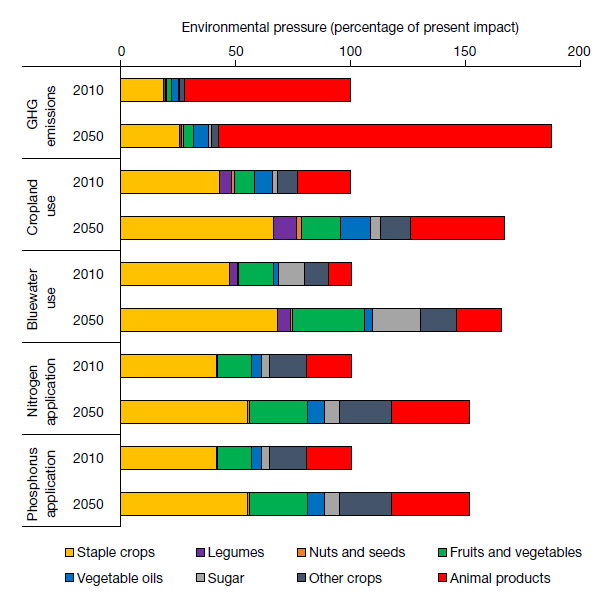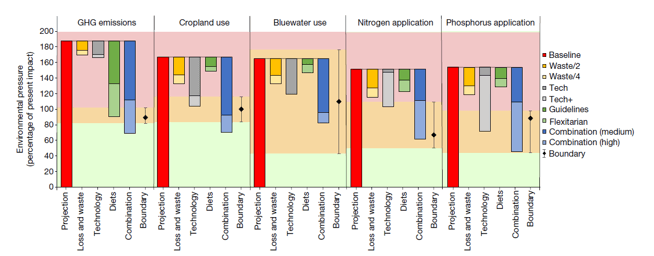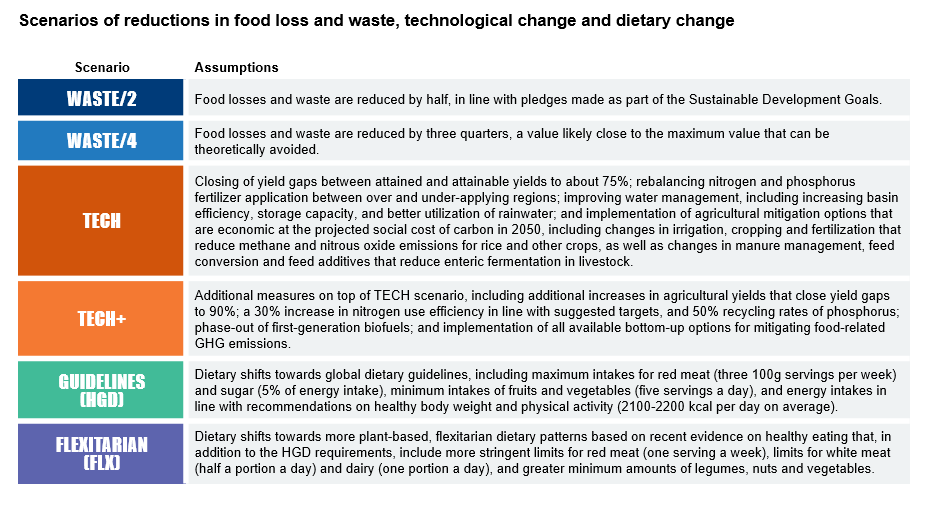At this time of year, food is always high on the agenda.
Consumers have been bombarded with messages about what food is ‘good’ for our health for over a century, and now claims about which foods are ‘good’ for the environment are also being added to the mix. Not only do consumers have to navigate misleading marketing claims from food manufacturers, even government dietary advice is formed by decades of lobbying and influence from the food companies too.
So, what food is actually ‘good’ for both people and the planet?
We’ve been spending some time looking at the independent academic evidence for this, and would like to share what we’ve found so far.
Background: the Need for a Sustainable Food System
Future demand for food will increase in the coming decades owing to changes in population size and income. By 2050, the world’s population is set to grow by around a third to 10 billion,[1] while global income as measured by GDP is estimated to triple.[2] Therefore, the food system will be put under intense pressure to provide for a larger population with a growing taste for animal products, which traditionally have a higher environmental impact.
Diet is inextricably linked to human health and the environment. Food production is the largest cause of global environmental change, accounting for 30% of greenhouse gas (GHG) emissions and 70% of freshwater use, as well as being the biggest driver of species extinction. Although we have seen reduced poverty and improved life expectancy as a result of the greater abundance of food, paradoxically 820 million people are undernourished while 2.1bn adults are overweight or obese. In fact, unhealthy diets are the largest global burden of disease, posing a greater risk to morbidity and mortality than unsafe sex, alcohol, drug and tobacco use combined.
It is clear the current food system is not sustainable, either in terms of the planet’s health or the health of those who populate it.
Figure 1:

Source: Options for keeping the food system within environmental limits, Charles Godfray et al. (2018)
The above chart estimates the impact different foods are set to have on the most vital environmental indicators vs. a 2010 baseline. Specific food groups affect these environmental indicators to varying extents; for example, note the significant impact of animal products on GHG emissions compared to their relatively small impact on freshwater use.
These impacts are not set to increase proportionately with population growth, as increases in global income will alter the types of food populations demand. Overall, environmental pressures of the food system are set to increase by 50-92% for each indicator, with the largest increase being seen in GHG emissions (87%) as demand for animal products grows.
With much of the world’s population inadequately nourished (meaning undernutrition, overnutrition and malnutrition) and many environmental systems being pushed beyond safe planetary boundaries, a global, system-wide transformation of the food system is urgently needed.
Defining a Sustainable Food System
The challenge is to deliver an environmentally sustainable system that works for both human and planetary health.
Two excellent academic papers have sought to define what a sustainable food system looks like in terms of human health and the environment: the first is by Springman et. al (2018) and discusses our options for keeping the food system within environmental limits, while the second – ‘Food in the Anthropocene’ from the EAT-Lancet Commission – considers how to achieve healthy diets from sustainable food systems (2019).
Both use a ‘planetary-boundaries’ approach to establish a safe range for vital environmental indicators, namely GHG emissions and climate change, freshwater use, nitrogen and phosphorous application, cropland use and biodiversity loss. A planetary-boundaries approach identifies and defines the biophysical safe operating space for environmental systems and processes which are essential for the stability of the planet. Exceeding these boundaries could lead to irreversible and potentially catastrophic shifts in the Earth’s systems.
Next, country-level consumption patterns are modeled to provide an estimation of potential future demand. Using these predictions, the papers provide a range of solutions and explore how various combinations of these could affect the key environmental indicators in 2050 vs. a baseline ‘business as usual’ approach. These are shown in Figure 2.
The solutions considered are reductions in food waste/loss, application of technologies and dietary changes. Two scenarios are considered for each, one of high ambition and one of medium ambition. These are defined in Figure 3. The ‘combination (medium)’ scenario includes the least ambitious of each potential solution, with the ‘combination (high)’ scenario including the most ambitious.
Figure 2:

Source: Options for keeping the food system within environmental limits, Charles Godfray et al. (2018)
Figure 3:

Source: Options for keeping the food system within environmental limits, Charles Godfray et al. (2018)
This chart leaves a few clear takeaways about what a sustainable food system should look like – and apologies if this makes you question what you had for Christmas lunch:
1. No single action is enough: a combination of measures is needed to reduce the environmental impact of food production.
2. Dietary change is the biggest driver of GHG emissions: Emissions simply cannot be reduced without a shift to more plant-based diets. With GHG emissions set to have the biggest rise by 2050, this absolutely has to be achieved. This has big implications for the manufacturers that produce meat and the retailers that sell it, and also makes the aquaculture industry (the farming of fish and other aquatic organisms) look particularly attractive as a source of lower-emission protein.
3. There are still some obvious wins in terms of efficiency, technology and food waste: According to this evidence, no further cropland expansion will be needed in 2050 if current yield gaps (the difference between attained and attainable yields) are closed to about 75% and food waste is halved.
Addressing climate change will necessitate huge changes to modern society, and lifestyle changes for all of us. While meaningful changes may be less drastic than popular discourse makes it seem, how we eat does have a pronounced impact on the planet, which will have a sizeable impact on the agricultural sector. As investors, it is our job to be paying attention to these trends, at our desks and, perhaps, in relation to our own lunches too!
[1] UN population data
[2] PwC, ‘The world in 2050’
Newton manages a variety of investment strategies. Whether and how ESG considerations are assessed or integrated into Newton’s strategies depends on the asset classes and/or the particular strategy involved, as well as the research and investment approach of each Newton firm. ESG may not be considered for each individual investment and, where ESG is considered, other attributes of an investment may outweigh ESG considerations when making investment decisions.
Any reference to a specific security, country or sector should not be construed as a recommendation to buy or sell this security, country or sector. Please note that strategy holdings and positioning are subject to change without notice.
Important information
This is a financial promotion. Issued by Newton Investment Management Limited, The Bank of New York Mellon Centre, 160 Queen Victoria Street, London, EC4V 4LA. Newton Investment Management Limited is authorized and regulated by the Financial Conduct Authority, 12 Endeavour Square, London, E20 1JN and is a subsidiary of The Bank of New York Mellon Corporation. 'Newton' and/or 'Newton Investment Management' brand refers to Newton Investment Management Limited. Newton is registered in England No. 01371973. VAT registration number GB: 577 7181 95. Newton is registered with the SEC as an investment adviser under the Investment Advisers Act of 1940. Newton's investment business is described in Form ADV, Part 1 and 2, which can be obtained from the SEC.gov website or obtained upon request. Material in this publication is for general information only. The opinions expressed in this document are those of Newton and should not be construed as investment advice or recommendations for any purchase or sale of any specific security or commodity. Certain information contained herein is based on outside sources believed to be reliable, but its accuracy is not guaranteed. You should consult your advisor to determine whether any particular investment strategy is appropriate. This material is for institutional investors only.
Personnel of certain of our BNY Mellon affiliates may act as: (i) registered representatives of BNY Mellon Securities Corporation (in its capacity as a registered broker-dealer) to offer securities, (ii) officers of the Bank of New York Mellon (a New York chartered bank) to offer bank-maintained collective investment funds, and (iii) Associated Persons of BNY Mellon Securities Corporation (in its capacity as a registered investment adviser) to offer separately managed accounts managed by BNY Mellon Investment Management firms, including Newton and (iv) representatives of Newton Americas, a Division of BNY Mellon Securities Corporation, U.S. Distributor of Newton Investment Management Limited.
Unless you are notified to the contrary, the products and services mentioned are not insured by the FDIC (or by any governmental entity) and are not guaranteed by or obligations of The Bank of New York or any of its affiliates. The Bank of New York assumes no responsibility for the accuracy or completeness of the above data and disclaims all expressed or implied warranties in connection therewith. © 2020 The Bank of New York Company, Inc. All rights reserved.






Comments